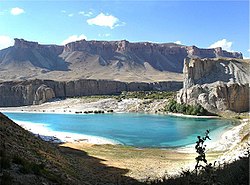Band-e Amir National Park

Band-e Amir National Park (Persian: بند امیر) is the first national park of Afghanistan. It is a stunning group of turquoise lakes in the Eastern zone of the country, in Bamyan Province. It sits high in the Hindu Kush at an altitude of 2900m, and in 2013 about 6,000 local tourists visit the site each year. The area is protected by a small number of park rangers and most of the landmines are cleared.
Get in
[edit]


Very remote and desolate, they are most easily visited from Bamiyan. Shared minivans leave in the high season on Thursday afternoon and Friday morning and cost 150 Af. Otherwise take a minivan towards Yakawlang (200 Af) and get off at the turn-off to the lakes. From there it's a 3-hour hot walk... bring some water.
Private hire minivans are also available (3 hours) and should cost 2000-2500 Af, but you will have to bargain very hard for this price. You could also negotiate an overnight stay into the price for a little extra. Don't be shy to ask them to stop for pics en route to the lakes, the scenery is stunning.
All services at the lakes close up around mid-November and reopen around March.
Get around
[edit]Walking is pretty much the only way to get around the area once you arrive, unless you were to befriend the owner of a donkey or horse.
See
[edit]
There are 5 lakes, all worth seeing and in close proximity.
If possible (and provided that you've stayed the night) try to be up on the road at the top of Band-e Haibat at sunrise (in October the ideal time was 06:00) for some great views and, if the water is calm, some gorgeous reflections of the surrounding mountains in the lake.
A trail from behind Hotel de Reves leads up the hill, and a 20-minute walk brings you to some stunning views of 2 more of the lakes.
The small mosque-like tomb of Amir looks over Band-e Haibat, and unfortunately there are 5 tacky swan peddle boats available for rent here... a good opportunity to ruin the beautiful reflections in the lake.
Behind the tomb of Amir is a women's beach, with a hut built half into the water, allowing women to enjoy a bath in the lake covered from curious views. Taking a bath in the lake is said to cure from diseases (though a lot of rubbish in and around the lake may lead one to fear the opposite).
Buy
[edit]At the parking lot near Band-e Haibat some booths are set up, selling some basics, with a very minimal selection... a few biscuits, some batteries, and maybe some mango juice packets.
Eat and sleep
[edit]Band-e Haibat is a teahouse and the only place to sleep and eat. A mat on the floor costs 100 Af/person, and meals are 120-150 Af. They also have 3 very basic dirty rooms in a building next door, ambitiously named Hotel de Reves (dream hotel). While you can have a more private room here, it's also just mats on the floor, and also 100 Af/person; most people prefer the much warmer main room at Dir. Often the local people will also huddle here on colder nights in a group, which is warmer than their private houses.
Camping – The adventurer among the visitors may use the public tent space near the only public toilet around. Sometimes tents are available to rent.
Drink
[edit]Bottled water is not available, but there is a fresh-water spring which should be fine to drink from (bring your own bottle, and take it with you when you leave). Dir Hotel can provide you with endless pots of green tea (5 Af).
Stay safe
[edit]Land mines used to be prevalent around this area, especially along the road that leads in from Bamiyan. Most have been cleared, but to be safe anyway, stick to well-worn paths, and don't stray more than a couple of feet from the main access road.
Go next
[edit]- Bamiyan – site of the destroyed Buddhas
- Yakawlang – the likely next stop if you're heading west/south towards Jam and Herat


 Français
Français Italiano
Italiano




